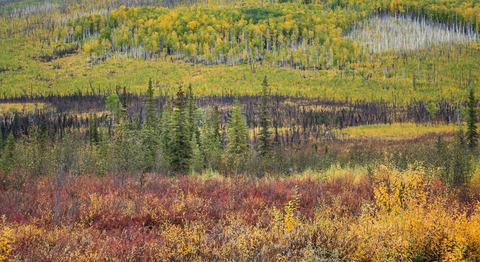Our official English website, www.x-mol.net, welcomes your
feedback! (Note: you will need to create a separate account there.)
An alternate vegetation type proves resilient and persists for decades following forest conversion in the North American boreal biome
Journal of Ecology ( IF 5.3 ) Pub Date : 2020-06-15 , DOI: 10.1111/1365-2745.13446 Winslow D. Hansen 1, 2 , Ryan Fitzsimmons 3 , Justin Olnes 4 , A. Park Williams 2
中文翻译:

另一种植被被证明具有韧性,并在北美寒带生物群落的森林转化后持续了数十年
更新日期:2020-06-15
Journal of Ecology ( IF 5.3 ) Pub Date : 2020-06-15 , DOI: 10.1111/1365-2745.13446 Winslow D. Hansen 1, 2 , Ryan Fitzsimmons 3 , Justin Olnes 4 , A. Park Williams 2
Affiliation

|
- Climate change and natural disturbances are catalysing forest transitions to different vegetation types, but whether these new communities are resilient alternate states that will persist for decades to centuries is not known. Here, we test how changing climate, disturbance and biotic interactions shape the long‐term fate of a deciduous broadleaf forest type that replaces black spruce after severe wildfires in interior Alaska, USA.
- We simulated postfire deciduous forest that replaced black spruce after severe fires in 2004 for tens to hundreds of years under different climate scenarios (contemporary, mid 21st century, late 21st century), fire return intervals (11–250 years), distances to seed source (50–1,000 m) and browsing intensities (background, moderate, chronic). We identified combinations of conditions where deciduous forest remained the dominant vegetation type and combinations where it returned to black spruce forest, transitioned to mixed forest (where deciduous species and black spruce co‐dominate) or converted to nonforest.
- Deciduous forest persisted in 86% of simulations and was most resilient if fire return intervals were short (≤50 years). When transitions to another vegetation type occurred, mixed forest was most common, particularly when fire return intervals were long (>50 years) and the nearest seed source was 500 m or farther. Moderate and chronic browsing also reduced deciduous sapling growth and survival, helping black spruce compete if fire return intervals were long and seed source was distant. Dry soils occasionally caused conversion to nonforest following short‐interval fire when simulations were forced with a late 21st‐century climate scenario that projects warming and increased vapor pressure deficit. Return to black spruce forest almost never occurred.
- Synthesis. Conversion from black spruce to deciduous forest is already underway at regional scales in interior Alaska, and similar transitions have been widely observed throughout the North American boreal biome. We show that this boreal deciduous forest type is likely a resilient alternate state that will persist through the 21st century, which is important, because future vegetation outcomes will shape biophysical feedbacks to regional climate and influence subsequent disturbance regimes.
中文翻译:

另一种植被被证明具有韧性,并在北美寒带生物群落的森林转化后持续了数十年
- 气候变化和自然干扰正在促使森林过渡到不同的植被类型,但是这些新社区是否是可持续的替代状态,这种状态将持续数十年到数百年尚不清楚。在这里,我们测试了不断变化的气候,干扰和生物相互作用如何塑造落叶阔叶林类型的长期命运,这种落叶阔叶林类型在美国阿拉斯加内部发生严重野火后取代了黑云杉。
- 我们模拟了在不同气候情景(当代,21世纪中叶,21世纪末),回火间隔(11–250年),距种子源的距离之后,在2004年遭受大火数十至数百年后,用大火取代落叶松后的落叶森林。 (50–1,000 m)和浏览强度(背景,中等,慢性)。我们确定了落叶林仍为主要植被类型的条件组合,以及返回到黑云杉林,过渡到混合林(其中落叶树种和黑云杉共同占主导地位)或转换为非林的条件组合。
- 落叶林在86%的模拟中持续存在,并且如果回火间隔较短(≤50年),则弹性最大。当发生向另一种植被类型的过渡时,混交林最为常见,特别是当回火间隔较长(> 50年)且最近的种子源为500 m或更远时。适度和长期的浏览还减少了落叶树苗的生长和存活,如果回火间隔较长且种子源较远,则有助于黑云杉竞争。在短时间隔大火之后,干旱土壤偶尔会导致转化为非森林,这是由于在21世纪后期的气候情景下进行模拟而造成的,这预示着气候变暖和蒸气压赤字增加。回到黑云杉林几乎从未发生过。
- 综合。在阿拉斯加内陆地区已经开始从黑云杉向落叶林转变,并且在整个北美北方生物群落中也观察到了类似的转变。我们表明,这种寒带落叶林类型可能是一种弹性的交替状态,它将持续到21世纪,这一点很重要,因为未来的植被结果将影响对区域气候的生物物理反馈并影响随后的干扰机制。











































 京公网安备 11010802027423号
京公网安备 11010802027423号